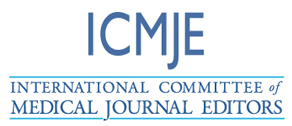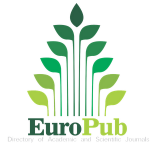Birth Order and Exclusive Breastfeeding Practices among Mothers with Two or More Children
Keywords:
Exclusive breastfeeding, Parity, Birth orderAbstract
Background: The promotion and support of breast-feeding is a global priority breastfeeding is recommended by multiple health agencies as the preferred method of infant feeding for at least six months because of its numerous benefits, both immediate and long term, for both mothers and babies. It has also been suggested that the duration a woman breastfeeds her first born is an important predicator of whether or not she will breastfeed a later-born child. This study aimed to determine the association between birth order and exclusive breastfeeding practices in families with two or more children.
Method: A cross sectional design was used for this study. A total of 288 mothers with two or more children attending Adeoyo Maternity Hospital, Yemetu were recruited using a systematic random sampling and a structured questionnaire was used to collect data on sociodemographic characteristics, birth history, knowledge and practice of breastfeeding. Chi-square test was used for bivariate analyses to test the significance of the association between categorical variables and the practice of exclusive breastfeeding. Logistic regression analysis was performed to identify independent predictors of exclusive breastfeeding. Level of significance was at 5%
Results: The mean age of mothers was 30.4 years (SD 4.4 years) while the mean age of the children was 56.0 months (SD 41.1 months). Exclusive breastfeeding was higher among the second and third children compared to the first, fourth and fifth children. However on logistic regression the differences were not significant. Mothers with three children were about three times more likely to have exclusively breastfed their children compared to mothers with four/five children. (OR=2.168. 95%CI= 1.307-3.596). Mothers from other ethnic group were significantly less likely to breastfeed exclusively than those who were Yoruba (OR=0.515, 95% CI=0.254-1.046)
Conclusion: The study shows that the factors influencing the practice of exclusive breastfeeding differ among mothers by birth order and parity. Efforts must be intensified to reiterate the benefits of EBF and address the identified hindrances irrespective of parity and birth order, via health education of the broader community to enlist family support for breastfeeding mothers. Strategies should also be put in place that would ensure the consistent practice of exclusive breastfeeding especially among mothers who have many children.
References
I. Aghaji MN. Exclusive breastfeeding practice and associated factors in Enugu, Nigeria. West Afr J Med 2002; 21: 66-69.
II. Ahmed, S., 1997. “Practical Support for Breast-feeding Mothers”. Postgraduate Doctor, 13:65-9.
III. American Academy of Pediatrics, Work Group on Breastfeeding. Breast-feeding and the use of human milk. Pediatrics 1997; 100: 1035–39.
IV. Arenz S, Rückerl R, Koletzko B, von Kries R (2004). "Breast-feeding and childhood obesity--a systematic review". Int. J. Obes. Relat. Metab. Disord. 28 (10): 1247–56.
V. Armstrong J, Reilly JJ 2002. "Breastfeeding and lowering the risk of childhood obesity". Lancet 359 (9322): 2003–4.
VI. Aye Kyi Kyi 2000. Factors Affecting Breast-Feeding In the Philippines: An Analysis Of 1998 NDHS Data.1.ISBN 974-664-647-8
VII. Bhavana Singh 2010 European Journal of Scientific Research,ISSN 1450-216X Vol.40 No.3 pp.404-422
VIII. Blaymore Bier JA, Oliver T, Ferguson A, Vohr BR 2002. "Human milk reduces outpatient upper respiratory symptoms in premature infants during their first year of life". J Perinatol 22 (5): 354–9.
IX. Briend, A., Wojtynaik, B. and Rowland, M.G.M., 1988. Breastfeeding, Nutritional State and Child Survival in Rural Bangladesh. British Medical Journal,296: 879-82.
X. Central Bureau of Statistics (CBS) [Indonesia] and State Ministry of Population./ National Family Planning Coordinating Board (NFPCB) and Ministry of Health (MOH) and Macro Internation Inc.(MI)1995.
XI. Centers for Disease Control and Prevention. http://www.cdc.gov/breastfeeding Retrieved 2007- 01-23.
XII. Chua S, Arulkumaran S, Lim I, Selamat N, Ratnam S (1994). "Influence of breastfeeding and nipple stimulation on postpartum uterine activity". Br J Obstet Gynaecol 101 (9): 804-5.
XIII. Code Work. World Wide Website: Covington CY: A review of "The National Breastfeeding Policy in Nigeria: the working mother and the law". Health Care Women Int 2005, 26(7):555-60
XIV. Der G, Batty GD, Deary IJ (2006). Effect of breastfeeding on intelligience in children. BMJ 333 (7575): 945.
XV. Dewey K, Heinig M, Nommsen L (1993). "Maternal weight-loss patterns during prolonged lactation". Am J Clin Nutr 58 (2): 162–6.
XVI. Dewey KG, Heinig MJ, Nommsen-Rivers LA (1995). "Differences in morbidity between breast- fed and formula-fed infants". J. Pediatr. 126 (5 Pt 1): 696–702.
XVII. Dewey KG, Heinig MJ, Nommwen LA. Maternal weight-loss patterns during the menstrual cycle. Am J Clin Nutr 1993;58: 162-166
XVIII. Eisenberg Arlene (1989). What to expect the first year. Workman publishing company. ISBN 08948057.
XIX. Eregie CO: Observations on water supplementation in breastfed infants. West Afr J Med 2001, 20(4):210-2.
XX. Evenhouse E, Reilly S (2005). Improved estimates of the benefits of breastfeeding using sibling comparism to reduce selection bias. Health Serv Res 40 (6 Pt 1): 1781–802.
XXI. Feachem RG, Koblinsky MA. Interventions for the control of diarrhoeal diseases among young children: promotion of breastfeeding. Bull World Health Organization 1984; 62:271–291.
XXII. Fein SB, Roe B. The effect of work status on initiation and duration of breastfeeding. Am J Public Health 1998;88:1042–1046.
XXIII. Feldman S (July–August 2000). Nursing through pregnancy. New Beginnings (La Leche League International)17(4):116–118,145. Retrieved 2007-03-15.
XXIV. Feyisetan BJ: Postpartum sexual abstinence, breastfeeding, and childspacing, among Yoruba women in urban Nigeria. Soc Biol 1990 , 37(1-2):110-27.
XXV. Forster DA, McLachlan HL: Breastfeeding initiation and birth setting practices: a review of the literature. J Midwifery Womens Health 2007, 52(3):273-80.
XXVI. Gartner LM, et al. (2005). Breastfeeding and the use of human milk (policy statement). Pediatrics 115 (2): 496–506.
XXVII. Glass RI, Svennerholm AM, Stoll BJ, et al. (1983). "Protection against cholera in breast-fed children by antibodies in breast milk". N. Engl. J. Med. 308 (23): 1389–92.
XXVIII. Greer FR, Sicherer SH, Burks AW (2008). "Effects of early nutritional interventions on the development of atopic disease in infants and children: the role of maternal dietary restriction, breastfeeding, timing of introduction of complementary foods, and hydrolyzed formulas". pediatrics (journal) 121 (1): 183–91.
XXIX. Hanna N, Ahmed K, Anwar N, Petrosa A, Hiatt M, Hegye T (2004). Effect of storage on breastmilk antioxidant activity. Arch Dis Child Fetal Neonatal ED (BMJ Publishing Group Ltd);pp F518-22.
XXX. Horta BL, Bahl R, Martines JC, Victoria CG (2007). Evidence on the long term effect of breastfeeding; systematic review and meta-analyses. Geneva, Switzerland:World Health Organization. ISBN 9789241595230. Retrieved 2010-04-05.
XXXI. Horwood LJ, Darlow BA, Mogridge N (2001). Breast milk feeding and cognitive ability at 7-8 years Arch. Dis. Child. Fetal Neonatal Ed. 84 (1): F23–7.
XXXII. Huffman, S.L.,1984. “Determinants of Breast-feeding in Developing Countries: Overview and Policy Implication”. Studies in Family Planning, 15 (4): 170-183.
XXXIII. Iwinski S (2006). Is weighing baby to measure milk intake a good idea. Studies in Family Planning, 42(3):513.
XXXIV. Iliyasu Z, Kabir M, Abuabakar IS, Galadanci NA. Current knowledge and practice of exclusive breastfeeding among mothers in Gwale Local Government Area of Kano State. Nig Med Pract 2005; 48: 50-55
XXXV. Kelly YJ, Watt RG, Nazroo Y: Racial/ethnic differences in breastfeeding initiation and continuation in the United Kingdom and comparison with findings in the United States. Pediatrics 2006 , 118(5):1428-35.
XXXVI. Kramer M, Kakuma R (2002). Optimal duration of exclusive breastfeeding. Cochrane Database Syst Rate
XXXVII. Kramer MS, Matush L, Vanilovich I (2007). Effet of prolong amd exclusive breastfeeding on risk of allergy and asthma; cluster randomised trial. BMJ 335 (7624): 815.
XXXVIII. Kruse L, Denk CE, Feldman-Winter L, et al. Longitudinal patterns of breastfeeding initiation. Matern Child Health J 2005;10:13–18.
XXXIX. Kunz C, Rodriguez-Palmero M, Koletzko B, Jensen R (1999). "Nutritional and biochemical properties of human milk, Part I: General aspects, proteins, and carbohydrates". Clin Perinatol 26 (2): 307–33.
XL. Leeson C, Kattenhorn M, Deanfield J, Lucas A (2001).duration of breastfeeding and arterial distensibility in early adult life; population based study. BMJ 322 (7287): 643–7.
XLI. Lovelady C, Garner K, Moreno K, Williams J (2000). "The effect of weight loss in overweight, lactating women on the growth of their infants". N Engl J Med 342 (7): 449–53.
XLII. Lucas A, Cole TJ (1990). "Breast milk and neonatal necrotising enterocolitis". Lancet 336 (8730): 1519–23.
XLIII. Mead M.N (2008). Contaminant in human milk. Weighing the risk against the benefit of breastfeeding. Environ Health Perspect; 116 (10);A462-34.
XLIV. Melton III L; Bryant S, Wahner H, O'Fallon W, Malkasian G, Judd H, Riggs B (March 1993). "Influence of breastfeeding and other reproductive factors on bone mass later in life". Osteoporosis International (London: Springer) 3 (2): 76.dio 10;1007/BF01623377
XLV. Mohrbacher N, Stock J (2003). The breastfeeding answer book (3rd (revised) ed.). Schaumburg, Ill.: La Leche League International. ISBN 0-912500-92-1
XLVI. Nigeria demographic and health survey 1999. Federal Office of Statistics, Lagos and IRD/Macro International Inc., Columbia, Maryland, USA, 1999: 34-37.
XLVII. Newburg DS, Peterson JA, Ruiz-Palacios GM. Role of human-milk lactadherin in protection against symptomaticrotavirus infection. Lancet 1998; 351: 1160–1164.
XLVIII. Newcomb P, Trentham-Dietz A (2000). "Breast feeding practices in relation to endometrial cancer risk, USA". Cancer Causes Control 11 (7): 663–7.
XLIX. Newman J, Pitman T (2000). Dr. Jack Newman's guide to breastfeeding. Harper Collins Publishers.
L. Nichols HB, Trentham-Dietz A, Sprague BL, et al (May 2008). Effect of birth order and maternal age on breast cancer risk; modification by whether women had been breastfed. Epidemiology 19 (3): 417–23.
LI. Nwankwo BO, Brieger WR: Exclusive breastfeeding is undermined by use of other liquids in rural southwestern Nigeria. J Trop Pediatr 2002 , 48(2):109-12.
LII. Ogunlesi A. Tinuade, Dedeke O.F. Olabisi, Okeniyi A.O.John, Oyedeji .A.Gabriel (2005) Infant and toddler feeding practices in the Baby Friendly Initiative (BFI) Era in Ilesa, Nigeria. The internet journals of Nutrition and Wellness; 1:2.
LIII. Ogbonna C, Okolo AA, Ezeogu A. Factors influencing exclusive breastfeeding in Jos, Plateau State, Nigeria. West Afr J Med 2000; 19: 107-110.
LIV. Owen CG, Martin RM, Whincup PH, Smith GD, Cook DG (2006). "Does breastfeeding influence risk of type 2 diabetes in later life? A quantitative analysis of published evidence". Am. J. Clin. Nutr. 84 (5): 1043–54.
LV. Perez-Bravo F, Carrasco E, Gutierrez-Lopez MD, Martinez MT, Lopez G, de los Rios MG (1996). "Genetic predisposition and environmental factors leading to the development of insulin-dependent diabetes mellitus in Chilean children". J. Mol. Med.74 (2): 105–9. Picciano M (2001). "Nutrient composition of human milk". Pediatr Clin North Am 48 (1): 53– 67.
LVI. Pikwer M, Bergström U, Nilsson JA (Apr 2009). "Breast feeding, but not use of oral contraceptives, is associated with a reduced risk of rheumatoid arthritis". Ann Rheum Dis 68 (4): 526–30.
LVII. Pisacane A, Continisio GI, Aldinucci M, D'Amora S, Continisio P (2005). A controlled trial of the fathers role in breastfeeding promotion. Pediatrics 116 (4): e494–8.
LVIII. Popkin BM, Adair L, Akin JS, Black R, Briscoe J, Flieger W.Breast-feeding and diarrheal morbidity. Pediatrics 1990; 86:874–882.
LIX. Price C; Robinson S (2004). Birth: Conceiving, Nurturing and Giving Birth to Your Baby. McMillan. pp. 489.
LX. Protecting, Promoting and Supporting Breastfeeding The Special Role of Maternity Services, a joint WHO/UNICEF statement published by the World Health Organization
LXI. Rayburn W, Piehl E, Lewis E, Schork A, Sereika S, Zabrensky K (1985). "Changes in insulin therapy during pregnancy". Am J Perinatol 2 (4): 271–5.
LXII. Renfrew MJ, Lang S. Early versus delayed initiation of breastfeeding. In: The Cochrane Library [on CD-ROM]. Oxford: Update Software;1998.
LXIII. Ruiz-Palacios G, Calva JJ, Pickering LK, et al. Protection ofb reast-fed infants against Campylobacter diarrhea by antibodies in human milk. J Pediatr 1990; 116: 707–713.
LXIV. Satcher DS. DHHS blueprint for action on breastfeeding. Public Health Rep 2001;116:72 -73
LXV. Scott JA, Binns CW. Factors associated with the initiation and duration of breastfeeding: A review of the literature. Breastfeed Rev 1999;7(1):5–16.
LXVI. Sears.com. (2006). Proper positioning and latch – on skill. Public Health 2006;33-34
LXVII. Shah, I.H and Khanna, J., 1990. "Breast-feeding, Infant Health and Child Survival in the Asia pacific Context”. Asia- Pacific population Journal 5(1): 25-44.
LXVIII. Sheehan D, Bridle B, Hillier T, Feightner K, Hayward S, Lee KS, Krueger P, Sword W,
LXIX. James M: Breastfeeding outcomes of women following uncomplicated birth in Hamilton Wentworth. Can J Public Health 1999 , 90(6):408-11.
LXX. Spatz D (2006). "State of the science: use of human milk and breast-feeding for vulnerable infants". J Perinat Neonatal Nurs 20 (1): 51–5.
LXXI. Stuart-Macadam P, Dettwlyer K (1995). Breastfeeding: biocultural perspectives. Aldine de Gruyter. pp. 131.
LXXII. Stuebe AM, Michels KB, Willett WC, Manson JE, Rexrode K, Rich-Edwards JW (2009).
LXXIII. Duration of lactation and incidence of infarction in middle to late adulthood. Am J Obstet Gynecol 200 (2): 138.e1–8.
LXXIV. Tully D.B, Jones F, TullyM.R (2001) Donor milk. What is in it and what is not. J Hum Lact;17(2);152-5.
LXXV. Uchendu UO, Ikefuna AN, Emodi IJ 2009.Factos associated with exclusive breastfeeding among mothers seen in the university of Nigeria teaching hospital. Enugu Nigeria Vol. 3 No.
LXXVI. UNICEF, 1994. World Breastfeeding Week-1994. Protect Breast-feeding: Making the Van Willigen J (2002). Applied anthropology: an introduction. Westport, CT: Bergin & Garvey.
LXXVII. Vennemann MM, Bajanowski T, Brinkmann B, Jorch G, Yücesan K, Sauerland C, Mitchell EA; GeSID Study Group (2009). Does breastfeeding reduce the risk of sudden infant death syndrome? Pediatrics123(3):e406-10.
LXXVIII. Widstrom AM, Wahlberg V, Matthiesen AS, Eneroth P, Uvnas-Moberg K, Werner S, et al. Short-term effects of early suckling and touch of the nipple on maternal behavior. Early Hum Dev 1990; 21:153-63.
LXXIX. Williams MJ, Williams SM, Poulton R (Feb 2006). Breastfeeding is related to C-reactive protein concentration in adult women. J Epidemiol Community Health 60 (2): 146–8.
LXXX. Wilson AC, Forsyth JS, Greene SA, Irvine L, Hau C, Howie PW. Relation of infant diet to childhood health: Seven years follow up of cohort of children in Dundee infant feeding study. BMJ 1998; 316:21-25.
LXXXI. Woolridge MW, Phil D, Baum JD. Recent advances inbreast-feeding. Acta Paediatr JJpn 1993;35:1-12.
LXXXII. World Health Organization. Exclusive breastfeeding. (2003) Global strategy for infant and young child feeding. Geneva, Switzarland; World Health Organizaton ISBN 924156218 Retrieved 2009-09-02











